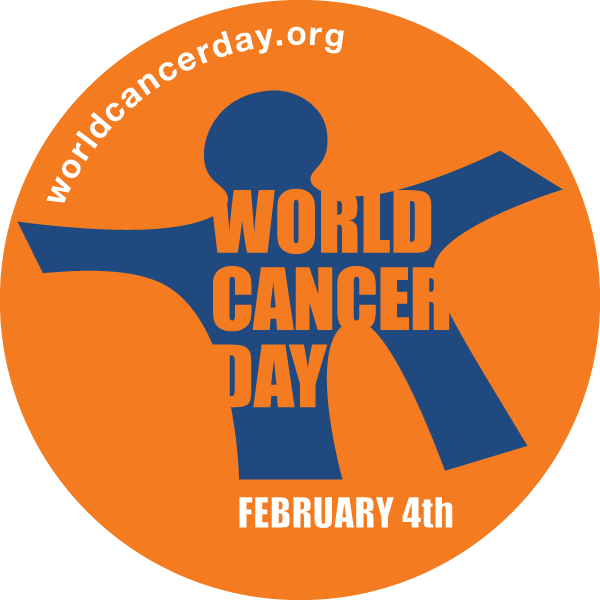World Cancer Day – A global event to help raise awareness of cancer. The goal is to reach as much as the world as possible. The single initiative under which the world can unite to raise the profile of cancer in a positive and inspiring way.

Spearheaded by the Union for International Cancer Control (UICC), World Cancer Day takes place for the last year under the tagline ‘We can. I can.’, which explores how everyone – as a collective or as individuals – can do their part to reduce the global burden of cancer. Just as cancer affects everyone in different ways, everyone has the power to take action to reduce the impact that cancer has. World Cancer Day is a chance to reflect on what you can do, make a pledge and take action.
World Cancer Day
This day was created around 2008 by Union for International Cancer Control (UICC). It is held annually on February 4th.
On World Cancer Day, cancer leaders call for equal access to reduce premature cancer deaths by 25%
- World Cancer Day 2018 highlighted the global equity gap in accessing early detection, treatment and care services
- UICC calls for more equal access to reduce premature cancer and non-communicable disease deaths by 25% by 2025 in line with WHO targets
- Consolidated country-by-country statistics on cancer incidences and moralities, national cancer control plans and registries and access to radiotherapy based on latest GLOBOCAN and WHO data
February 4 – World Cancer Day: World Cancer Day raises awareness of the millions of people
The global target of a 25% reduction in premature deaths from cancer and non-communicable diseases* (NCDs) by 2025 is possible. However, to deliver on this global commitment†, the current inequities in risk factor exposure, and in access to screening, early detection and timely and appropriate treatment and care, must be addressed.
Professor Sanchia Aranda, President of UICC and CEO of Cancer Council Australia:
“Set in 2011, the World Health Organization’s target to cut premature NCD deaths by 25% within 14 years is coming towards its half way mark. We can meet the target, but more action than ever will be required. Inequality in access to prevention, diagnosis, treatment and care makes reducing premature deaths from cancer difficult. If we are committed to achieving this goal, we must act quickly and decisively to make access to cancer services more equal all around the world.”
World Cancer Day, led by the Union for International Cancer Control (UICC), every year rallies the world’s voices against what the World Health Organization (WHO) recently recognized for the first time as the leading cause of global morbidity1.
Today, there are an estimated 8.8 million deaths from cancer every year2. However, it is the low- to middle income countries who are bearing the brunt, as approximately 70% of deaths occur in developing countries, which are the most ill-equipped to cope with the cancer burden3. The starkest area of inequity relates to childhood cancers – a specific group that the WHO underscored in its landmark 2017 Cancer Resolution – with survival rates over 80% in high income countries and as low as 20% in low income countries4.
Inequities are also acutely experienced in high- to middle-income countries, particularly within certain populations, including the indigenous, immigrant, refugee, rural, and lower-socioeconomic populations.
Professor Sanchia Aranda:
“In the last year of the ‘We can. I can.’ campaign for World Cancer Day, we hope to inspire real action from governments and civil society in addressing the inequities in cancer diagnosis, treatment and care, which unfortunately largely affects the most vulnerable populations in every country. In Australia, while we maintain some of the best cancer outcomes in the world, national data shows that the gap between those in the highest and lowest socioeconomic groups is continuing to widen over time. These overlooked voices must be more forcefully represented in our discussions this World Cancer Day.”
An acute example of a global access gap particularly affecting the undeserved and underprivileged is access to radiotherapy. As one of the major methods of treatment for cancer‡, radiotherapy is recommended for 52% of cancer patients5. Glaringly, the gap between need and availability is highest in low- to middle income countries; 90% of low- to middle-income country cancer patients lack access to radiotherapy6. Yet, issues of access to this critical treatment also cuts across many countries. In mainland China, there exists a gross shortage of radiotherapy facilities, with access varying widely from province to province. Depending on where you live in England§, patients can face significant variation – anywhere from 20% to 70% – in
accessing Intensity Modulated Radiotherapy, an advanced form of radiotherapy treatment7.
As an urgent response to the global equity gap and the critical need for an in-country response, UICC today officially launched, Treatment for All. It marks the second new initiative by UICC in as many years to mobilize national action to improve access to diagnosis and treatment for cancer, and is a direct acknowledgement that the cancer burden cannot be alleviated exclusively through prevention to reduce cancer incidence. Dr Cary Adams, Chief Executive Officer of UICC:
“The tsunami of cancer cases anticipated in the coming decades requires a persuasive and robust response at all levels – global and national. Treatment for All, in tandem with its sister initiative, C/Can 2025: City Cancer Challenge, will work to accelerate progress by translating global commitments to evidence-, safety- and quality based national actions.”
By empowering individuals, cities, countries and governments to lever Treatment for All’s four pillars of cancer treatment and care, we can achieve:
- Improved quality of cancer data for public health use
- Increased number of people with access to early detection and accurate cancer diagnosis
- Greater timely and quality treatment for early and metastatic disease
- At a minimum, basic supportive and palliative care service for the current 32.6 million people living
with cancer8.
On World Cancer Day, ‘We can. I can.’ improve access and deliver on the global target of a 25% reduction in cancer and NCD premature deaths by 2025
About World Cancer Day activities and grassroots events
Local and international associations around the world are coming together to hold events dedicated to raising awareness and education about cancer, including the Chain for Change in Canada and the One Step at a Time Cancer Warrior Walk in South Africa. For more information about specific events, please visit: www.worldcancerday.org/map
About the Union for International Cancer Control (UICC)
UICC is the largest international cancer-fighting organization, with over 1,000 member organizations across 160 countries representing the world’s major cancer societies, ministries of health, research institutes, treatment centers and patient groups. The organization is dedicated to taking the lead in convening, capacity building and advocacy initiatives that unite the cancer community to reduce the global cancer burden, promote greater equity, and integrate cancer control into the world health and development agenda.
UICC and its multi-sectorial partners are committed to encouraging governments to look towards the implementation and scale-up of quality and sustainable programs that address the global burden of cancer and other NCDs. UICC is also a founding member of the NCD Alliance, a global civil society network that now represents almost 2,000 organization in 170 countries.
For more information, please visit: www.uicc.org
About Treatment for All
Over the last seven years, the Union for International Cancer Control (UICC) has united the cancer community to position cancer on the global health and development agenda, with the inclusion of cancer and non-communicable diseases in the Sustainable Development Goals (SDGs) in 2015 and culminating in the successful adoption of a cancer resolution at the World Health Assembly in 2017.
‘Treatment for All’ is the name of a new, bold and inspiring advocacy initiative run by UICC. It calls on the international cancer community to address the global equity gap in access to cancer services by getting behind four essential pillars of cancer treatment and care:
- Improving the quality of cancer data for public health use
- Increasing the number of people with access to early detection and accurate cancer diagnosis
- Providing timely and quality treatment for early and metastatic disease for all
- Providing a basic supportive and palliative care service for all.
For more information, please visit: www.uicc.org/TreatmentforAll
For more information, please visit: www.worldcancerday.org
Footnotes:
*Non-communicable – or chronic – diseases are diseases of long duration and generally slow progression. The four main types are cardiovascular diseases, cancer, chronic respiratory diseases and diabetes.
†The global community has committed to reduce premature deaths from cancer and NCDs by 25% by 2025 as set out in the Global Action Plan for the Prevention and Control of Non-communicable Diseases
‡The major modalities of treatment for cancer includes radiotherapy, surgery and medicines including chemotherapy
§The wide disparity in cancer services and patient outcomes depending on where you live is often called the Postcode Lottery
- World Health Organization (2017) Seventieth World Health Assembly, Agenda item 15.6: Cancer prevention and control in the context of an integrated approach
[Accessed:21.12.17] http://apps.who.int/gb/ebwha/pdf_files/WHA70/A70_R12-en.pdf - World Health Organization (2017) Cancer Fact Sheet. [Accessed:20.12.17] http://www.who.int/mediacentre/factsheets/fs297/en/
- World Health Organization (2017) Cancer Fact Sheet. [Accessed:20.12.17] http://www.who.int/mediacentre/factsheets/fs297/en/
- Childhood Cancer International, 8 Reasons why Childhood Cancer should be a global child health priority [Accessed:10.01.2018] http://childhoodcancerinternational.org/8-reasonswhy-
childhood-cancer-should-be-a-global-child-health-priority/ - Barton, Frommer & Shafiq (2006) Role of radiotherapy in cancer control in low-income and middle-income countries, Lancet Oncology 7(7): 584-595 [Accessed
24.04.2017] http://thelancet.com/pdfs/journals/lanonc/PIIS1470-2045(06)70759-8.pdf - Zubizarreta et al. (2015) Clin Oncol (R Coll Radiol) 27(2):107-14 [Accessed 24.04.2017] https://www.ncbi.nlm.nih.gov/pubmed/25455407
- Staffurth, Ellison, Ball & Hanna (2015) Patterns of IMRT delivery in England [Accessed 3.01.2018]
https://www.google.ch/url?sa=t&rct=j&q=&esrc=s&source=web&cd=3&cad=rja&uact=8&ved=0ahUKEwiL4dri_rvYAhWIIuwKHXZbAxAQFgg5MAI&url=http%3A%2F%2Fwww.natcans
at.nhs.uk%2Fdlhandler.ashx%3Fd%3Dpubs%26f%3DNCRI_IMRT%25202015%2520v1.4.pdf&usg=AOvVaw3n79oHHaBi1fiN2vywn_3E - GLOBOCAN 2012 (International Agency for Research on Cancer), Estimated Cancer Incidence, Mortality and Prevalence in Nigeria in 2012 [Accessed: 20.12.17]
http://globocan.iarc.fr/Pages/fact_sheets_cancer.aspx
Submitted Press Release by UICC. Additions by myself. First published February 3, 2018. Last updated February 4, 2024.
Check out Courageous Christian Father’s Wish list on Amazon where you can purchase and this items sent directly to him and they will be used for the ministry.
Subscribe To Courageous Christian Father!
Don’t miss any blog posts! Subscribe today! You can subscribe via WordPress or by entering your email! Thank you!
Follow Courageous Christian Father on WordPress.comFollow Courageous Christian Father on Social Media
Recent Posts:
Below are some examples of blog entries from all the blogs that I do. (Courageous Christian Father, Steve Sews Stuff, SteveZ DuckZ, and SteveZ DesignZ).
Thank You For Reading Courageous Christian Father!
Thank you for reading. Please feel free to share and like this blog post.
Clipart: Unsplash, Pixabay, Pexels, Openverse, Adobe Express, Adobe Stock, FreePik, MetroCreative, and more. This site uses Amazon Affiliate Ads & Google Ads.
About the Author
Discover more from Courageous Christian Father
Subscribe to get the latest posts sent to your email.


